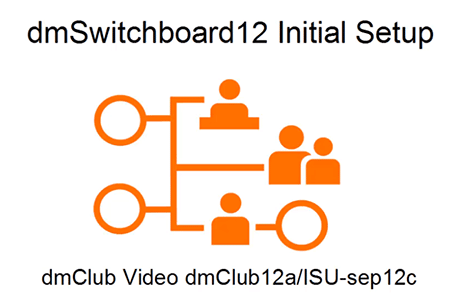Get started with dmSwitchboard12
![]() There are several approaches to getting up-and-running with your switchboard. You can do-it-yourself, with the help of our video tutorials and instructions, take advantage of the free ProTime setup assistance included with every switchboard, or mix the two approaches (try DIY, then use ProTime).
There are several approaches to getting up-and-running with your switchboard. You can do-it-yourself, with the help of our video tutorials and instructions, take advantage of the free ProTime setup assistance included with every switchboard, or mix the two approaches (try DIY, then use ProTime).
This note should help you to make an informed decision on the best approach to take.
Contents
Objective and duration
How to make your decision
Step 1: Make your decision
Step 2: Do-it-yourself
Step 3: Book ProTime
Related content
Objective and duration
This note should allow you to make an informed decision within 15 minutes on the best approach to switchboard set-up for you.
How to make your decision
The best approach for you will depend on how comfortable you are with planning, how familiar you are with technical aspects of switchboards, and on how much you want to learn.
The advice here will help you to decide whether you should:
- set up your switchboard yourself
- use ProTime
- or take the combined DIY + ProTime approach
Factors affecting you decision
Consider the following questions. The more confident you are, the greater your likelihood of benefitting from one of the approaches involving a 'do-it-yourself' element.
- Are you skilled at business process design. Can you clearly state how you want calls to be handled? The bigger your company the more work it takes to express this crisply.
- Do you have a good understanding of what a switchboard is and what it can do?
- Do you have a basic grasp of VOIP: what it is, how it works, and what its requirements are?
- Do you understand telephony terminology: voicemail, phasing, PSTN, DDI, and so on...?
Comparison of set-up approaches
Some are quicker, some more cost effective, and with some you learn more.
| DIY | DIY + ProTime | ProTime | |
|---|---|---|---|
| Your technical ability |
Good. You are technically sure-footed and comfortable with switchboard terminology. |
Fairly good. You understand the basics, and would like to give switchboard set up a go, confident in the knowledge that you can always use ProTime later. |
Not particularly good. You are not particularly technical, and know that you need help to get your switchboard up-and-running. |
| Short term cost effectiveness |
Neutral. You're not saving money bu doing it yourself, as ProTime is included in the price of dmSwitchboard12. |
Neutral. ProTime is included in the price of dmSwitchboard12. |
Neutral. ProTime is included in the price of dmSwitchboard12 |
| Long term cost effectiveness |
Good. You learn about controlling your switchboard, allowing you to make changes more easily in the future. |
Very good. The combined DIY + ProTime approach is usually the most cost-effective in the long run. You get the most out of ProTime, having already started going up the learning curve with you switchboard's controls. |
Moderately good. You won't learn as much about your switchboard, so won't have a head start when the time comes to make changes. |
|
Your time |
Most. Taking the DIY approach takes the most time. You'll go up the learning curve with dmSwitchboard12, which may save you time later. |
Second most. Taking the combined approach may be a good investment. You'll go up the learning curve with dmSwitchboard12, which may save you time later. |
Least. You'll take full advantage of assisted set-up, but will not learn as much about how to make modifications. |
| Time until setup |
Quickest This is the fastest way if you can manage it, as you don't have to book a ProTime session. We recommend that you spend no more than half-an-hour trying to get your switchboard working before using ProTime. |
Slowest. The combined approach is slightly slower than using ProTime form the start. |
Second quickest. |
| Knowledge transfer / learning about your switchboard |
Fairly good. The DIY approach is a good way to familiarise yourself with your switchboard's capabilities and controls. |
Good. The DIY approach is a good way to familiarise yourself with your switchboard's capabilities and controls. Once you have done this you can use ProTime to confirm your knowledge and ask advanced questions. |
Not especially good. The more you rely on our experts, the less you'll learn about your switchboard's capabilities and controls. |
Step 1: Make your decision
Having reviewed the advice above, either:
- Do-It-Yourself. Go to step 2 below.
- Do-It-Yourself, then take advantage of ProTime. Follow steps 2 and 3 below.
- Take advantage of ProTome. Go to step 3 below.
Step 2: Do-it-yourself
Setting up your first plan should take no more than half-an-hour. If you get stuck you can always turn to ProTime.
Overview of plan creation

-
Download the planning sheet (a Word document) and fill it in (see a completed example for pointers)
- Go to your switchboard's control panel by clicking on its icon in your clubhouse
- Under the Plans tab click New Plan
- Put your details in, save the plan, and activate it
Detailed instructions
Watch the video tutorial: We created this 5 minute video to help you get started. It shows you how to use your switchboard's Plan Manager and Plan Editor, then introduces your free WebPhone.
Follow our written guide: See #5022 Plan creation and editing
Step 3: Book ProTime
Book your free ProTime session here (#5082 Setup ProTime for dmSwitchboard12)
How it works: After you've completed the switchboard planning sheet we'll make an appointment, and one of our experts will help you to create your first plan.
Related content
#5022 Guide to creating and editing dmSwitchboard Plans
#5081 Introduction to ProTime
#5082 Setup ProTime for dmSwitchboard12